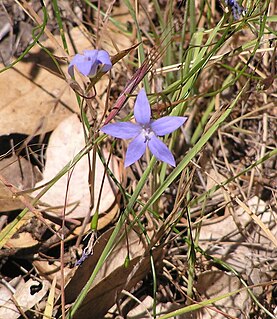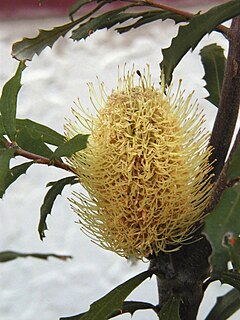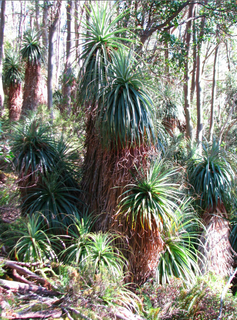
Campanula is one of several genera of flowering plants in the family Campanulaceae with the common name bellflower. It takes both its common and its scientific name from its bell-shaped flowers—campanula is Latin for "little bell".

Wahlenbergia gloriosa, commonly known as royal bluebell is a perennial herb in the bluebell family Campanulaceae. It has egg-shaped leaves near the base of its stem, linear leaves higher up and usually a single purple flower with a tube-shaped base. The flower is the floral emblem of the Australian Capital Territory.

Diselma archeri is a species of plant of the family Cupressaceae and the sole species in the genus Diselma. It is endemic to the alpine regions of Tasmania's southwest and Central Highlands, on the western coast ranges and Lake St. Clair. It is a monotypic genus restricted to high altitude rainforest and moist alpine heathland. Its distribution mirrors very closely that of other endemic Tasmanian conifers Microcachrys tetragona and Pherosphaera hookeriana.

Wahlenbergia is a genus of around 260 species of flowering plants in the family Campanulaceae. Plants in this genus are perennial or annual herbs with simple leaves and blue to purple bell-shaped flowers, usually with five petals lobes. Species of Wahlenbergia are found on all continents except North America, and on some isolated islands, but the greatest diversity occurs in the Southern Hemisphere.

Banksia canei, commonly known as the mountain banksia, is a species of shrub that is endemic to southeastern Australia. It is generally encountered as a many-branched shrub that grows up to 3 m (10 ft) high, with narrow leaves and the yellow inflorescences appearing from late summer to early winter. The old flowers fall off the spikes, and up to 150 finely furred follicles develop, which remain closed until burnt in a bushfire. Each follicle bears two winged seeds. Response to fire is poorly known, although it is thought to regenerate by seed. Birds such as the yellow-tufted honeyeater and various insects forage among the flower spikes. It is frost tolerant in cultivation, but copes less well with aridity or humidity, and is often short-lived in gardens. One cultivar, Banksia 'Celia Rosser', was registered in 1978, but has subsequently vanished.

Banksia saxicola, the rock banksia or Grampians banksia, is a species of tree or shrub in the plant genus Banksia. It occurs in Victoria in two distinct populations, one in The Grampians and the other on Wilsons Promontory. Formerly considered to be a form of B. integrifolia, it was described as a distinct species by Alex George in 1981. It is most closely related to Banksia marginata.

Banksia kingii is an extinct species of tree or shrub in the plant genus Banksia. It is known only from fossil leaves and fruiting "cones" found in Late Pleistocene sediment at Melaleuca Inlet in western Tasmania. These were discovered by Deny King in the workings of his tin mine. The climate was most likely as cool as or cooler than it is at Melaleuca now , and possibly wetter, over 2400 mm annually.

Gaultheria hispida, commonly known as the copperleaf snowberry, is an endemic eudicot of Tasmania, Australia. It is an erect multi-branched shrub, that can be found in wet forests and alpine woodlands. Its berries appear snowy white and leaves are tipped with a copper tinge, hence the common name.

Bellendena montana, commonly known as mountain rocket, is a species of low-growing multi-stemmed shrub in the plant family Proteaceae. It is endemic to high-altitude subalpine and alpine regions in Tasmania, Australia. The prominent white flower spikes appear over summer, followed by small bright red or yellow fruit in late summer and autumn.

Richea pandanifolia, the pandani or giant grass tree, is a distinctive endemic Tasmanian angiosperm. It is dicot of the family Ericaceae and is found in central, western and south west Tasmania. It is a favourite among hikers and nature lovers.

Pterygopappus is a genus of flowering plants in the pussy's-toes tribe within the daisy family. There is only one known species Pterygopappus lawrencii which is endemic to alpine Tasmania. It forms thick, light blue/green mats with densely packed leaves. It is most common in the mountains of the northeastern part of the island. It is a slow grower and prefers cool, moist environments.

Persoonia gunnii is a species of flowering plant in the family Proteaceae and is endemic to Tasmania. It is an erect shrub with young branchlets that are hairy at first, spatula-shaped to egg-shaped leaves with the narrower end towards the base, and white to cream-coloured flowers.

Orites revolutus , also known as narrow-leaf orites, is a Tasmanian endemic plant species in the family Proteaceae. Scottish botanist Robert Brown formally described the species in Transactions of the Linnean Society of London in 1810 from a specimen collected at Lake St Clair. Abundant in alpine and subalpine heath, it is a small to medium shrub 0.5 to 1.5 m tall, with relatively small, blunt leaves with strongly revolute margins. The white flowers grow on terminal spikes during summer. Being proteaceaous, O. revolutus is likely to provide a substantial food source for nectivorous animal species within its range.

Hesperocodon hederaceus, synonym Wahlenbergia hederacea, also known as the ivy-leaved bellflower, is a species of flowering plant that is found throughout Europe. It is the only species in the genus Hesperocodon. The delicate, patch-forming, hairless perennial herb has thin, creeping stems about 20 cm in length. Its pale green leaves are long-stalked and have an ivy-shaped, rounded structure. These leaves can be described as having a cordate shape and are approximately 5–12 mm long and wide. The plant has erect, solitary, pale blue flowers in summer and autumn, with bell-shaped corolla with 5 short lobes. The flowers are 6–10 mm long x 5–8 mm wide and sit on fine stalks 1–4 cm long. It is suggested that the long pedicels are an adaptation to assist in seed dispersal.

Campynema is a genus in the family Campynemataceae first described in 1805. It contains only one known species (monotypic), Campynema lineare, endemic to the island of Tasmania in Australia. Its closest relative is Campynemanthe, endemic to New Caledonia, sole other genus of the family.

Astelia alpina called pineapple grass, silver astelia, or perching lily is a commonly found species in alpine and subalpine areas of Tasmania and the Australian Alps. It is a perennial herb that typically dominates its environment by growing in dense clusters, called mats, in alpine bogs. There are two subspecies: Astelia alpina var. novae hollandiae from New South Wales and Victoria and Astelia alpina var. alpina endemic to Tasmania. Both subspecies appear very similar to each other. The species was originally described by Robert Brown.

Hakea lissosperma, commonly known as needle bush and mountain needlewood, is a species of Hakea native to parts of south eastern Australia.
Wahlenbergia ceracea, commonly known as the waxy bluebell, is a small herbaceous plant in the family Campanulaceae native to eastern Australia.

Wahlenbergia littoralis is a small herbaceous plant in the family Campanulaceae native to eastern Australia.

Coprosma moorei, commonly known as blue matcurrant or turquoise coprosma, is a small, mat forming, prostrate shrub in the Rubiaceae family. It is native to highland areas of Tasmania and Eastern Victoria.


















